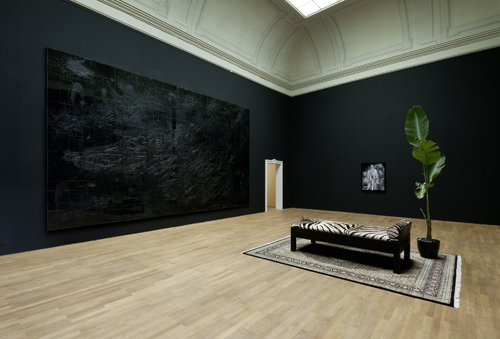Rashid Johnson
Kunsthalle Winterthur
Kunsthalle Winterthur

Three Rooms, the succinct title of Rashid Johnson’s exhibition at Kunsthalle Winterthur, was a kind of small-scale survey. On view were a handful of works from the past five years demonstrating the various ways in which Johnson has drawn from the inventory of signs in African American (pop) culture and history to sample and reinterpret them.
In the 2013 installation Samuel in Space (with shea butter and Persian rug), for instance, Johnson branded a modified version of the hip hop group Public Enemy’s target logo onto a Persian rug. Also on view were two versions from the series The New Negro Escapist Social and Athletic Club (2008–ongoing; here from 2009 and 2011). For this series he creates evocative black and white photographic portraits, frequently double exposed, which have a style somewhere between Harlem Renaissance and Sun Ra’s Afrofuturism. Johnson uses shea butter, an oily skin cream made from the fruit of the African shea tree, to form balls and lumps, to fashion a pedestal for a video monitor (for the above-mentioned Samuel in Space…), or sculpt a roughly formed bust (Untitled, 2014). Over the years, Johnson’s use of this material – the colour of which can be referred to as ‘off-white’, a term that carries undertones of racial identity and skin colour – has become something of a personal trademark.
Two works in particular demonstrated just how enigmatically Johnson plays with issues of classification and attribution. The New Black Yoga (2011), a short 16mm film, showed five young men on the banks of a lake performing an improvised choreography made up of martial arts, yoga, tai chi, and other forms of ’Eastern-looking’ physical training. Ultimately these gestures and poses are vacuously appropriated pop cultural signs of the kind used by hip hop group Wu-Tang Clan in the 1990s, or Jim Jarmusch in his film Ghost Dog: The Way of the Samurai (1999). In their slapstick delivery, the actors seemingly poke fun at their own cross between martial arts, mysticism, militancy, and skin colour. Issues of interiority, mediation, spirituality and authenticity seem nothing more than superficial signs.
Also included was one of Johnson’s multi-sided wall panel sculptures: part painting, part shelving unit in which books, records and objects are arranged. These embody a kind of sarcastic, historically aware take on interior design and identity formation – self-design as historical compartmentalizing. Atop the shelves jutting out from the mirror panels of 2×3 (2014) were two LP versions of Bob James’s jazz-fusion classic Three (1976). The elegant covers feature a deep black background and a ray of light refracted like a prism into a colour spectrum. They differ in the fact that each features the name of the black guest star, Grover Washington Jr., in a different colour. Bob James, the key-board player on this much-sampled record is white. Questions of skin colour enter the picture in a fairly uncomfortable way. What seems at stake is the projections and expectations of what is probably a predominantly white audience. The viewer stood there (this one included) a bit embarrassed, and saw far more than their own reflection in the mirrored object.
This work makes clear where the true strength of Johnson’s position lies: the more convincingly it employs cultural codes to toy with categories, the more it presents these as empty. The repeated appearance of interior design references – rugs, shelves, a couch covered in zebra skin and an indoor plant, Untitled (Daybed 6) (2012) – moved the focus from identity politics to questions of taste. What was once content is now container, what was once called Pop is now called art. And it decorates the apartments of rich, predominantly white collectors. This is precisely where the perfidious twist lies: African-American history is sold as politically correct design. You can’t get any more ruthless than that.
Translated by Andrea Scrima















